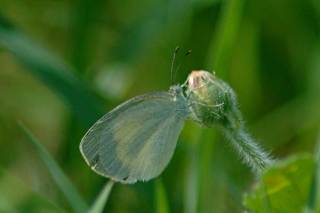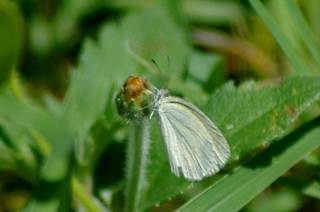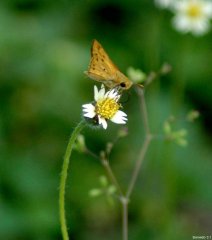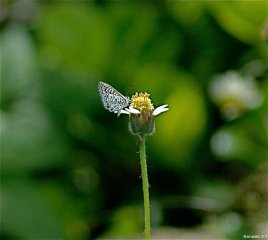Lots and lots of insects are small. Even butterflies, those showy, gaudy, colorful things, can be very small (they can also be pretty big, of course). The other day I was out weeding the front yard when I noticed this little teeny tiny butterfly in the grass:
In this photo, which is backlit, you can see the faint yellow patterning through the wings. But since I couldn’t see that through my viewfinder (it’s a small butterfly, remember?), I decided to crawl around to the other side, so I could have the sun behind me:
And that’s when I was able to see it a little more clearly. For perspective, the flower bud it’s perched on is 3/8″ from top to bottom. My lens won’t focus any closer than 7 or 8 feet, so even though this weak flier wasn’t budging when I was close enough to see it better, I couldn’t get a picture from that close. Drat.*
This tiny little butterfly is a pierid; that is, a member of the family Pieridae, commonly known as Whites and Yellows. All the sulphurs are in this family as well. (The sulphurs, though, are quite a bit larger than this little guy.) The Pieridae, like most families of organisms, come in a wide range of sizes. By the way, the pierids get their name from the Pierides, who are, depending on who the naming author had in mind, either the Muses themselves, or the nine daughters of Pierus whose claim to fame comes from having challenged the nine Muses to a contest of song (Rosso Fiorentino painted a picture of this contest in the 16th century, and Karel van Mander later drew a cartoon of it.). Of course the mortal maidens lost their challenge of the gods, and were transformed into birds (some say magpies, others say a different species for each daughter; this latter makes sense, because the name of at least 5 of the nine Pierides is the name, in Greek, of a different bird**). Whether the butterfly family is named for the immortal or the mortal maidens, the name conjures up images of antique art and flowing, diaphanous robes, which I suppose is appropriate, given the general look of these butterflies.
So anyway, this pierid butterfly is Eurema daira, commonly known as the Barred Yellow. It’s pretty common here in Florida, at least in my experience. It’s even more common in winter in south Florida, according to my BTB (Butterflies Through Binoculars), because these guys “[migrate] southward from north to south Florida in the fall” (61).
I realize now that I’d seen this species in my lawn many times before, but because they’re so small I’d never been able to identify them until I got these pictures. So that’s one more mystery solved by a willingness to lie belly down in the grass with a camera. Yay!
Other butterfly species that enjoy the flowers in my lawn are Hylephila phileus, Fiery Skipper:
and Leptotes cassius, Cassius Blue:
So, all told, I’ve got small representatives from 3 of the 7 groups in my BTB: Pierids, Skippers, and Gossamer-Wings. Of course, some of these groupings have subgroupings; pierids don’t, but skippers (family Hesperiidae) are such a large family that many people think they’re really a third type of lepidopteran, (moths, butterflies, and skippers), instead of just a family in the butterfly group. H. phileus is a Grass-Skipper (currently subfamily Hesperiinae). And my Gossamer-Wing, L. cassius, is one of the many Blues in the large family Lycaenidae.
Ain’t taxonomy fun?
References
Glassberg, J. (1999). Butterflies Through Binoculars: The East. NY:Oxford UP.
* Plus, I suffer from an undiagnosed neuromuscular condition known (by me) as “can’t hold telephoto lenses steady,” which means that, without a VR lens, my handheld images are always a bit out of focus. I’m not alone in this. This condition afflicts nearly 100% of the photographers in the world. Seriously. Read any book on photography. They will all say the same thing: use a tripod! Or a VR lens.
** From the dreaded Wikipedia: “Colymbas, lyngx, Cenchris, Cissa, Chloris, Acalanthis, Nessa, Pipo, and Dracontis. These names were taken from actual names of birds in ancient Greek, such as the wryneck, hawk, jay, duck, goldfinch, and four others with no recognizable modern equivalents.” From my Lempriere, “It may perhaps be supposed, that the victorious Muses assumed the name of the conquered daughters of Pierus, and ordered themselves to be called Pierides, in the same manner as Minerva was called Pallas because she had killed the giant Pallas.”




